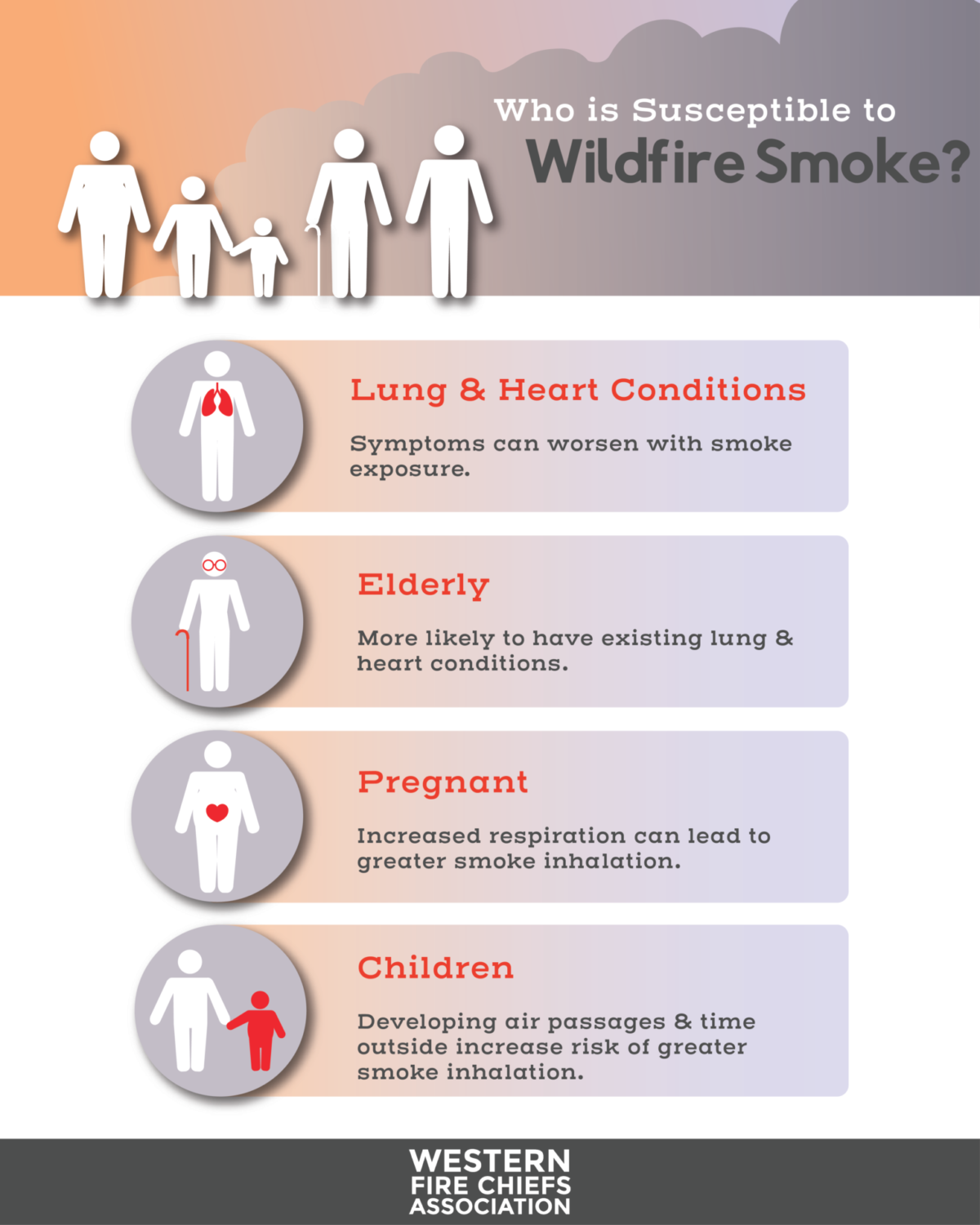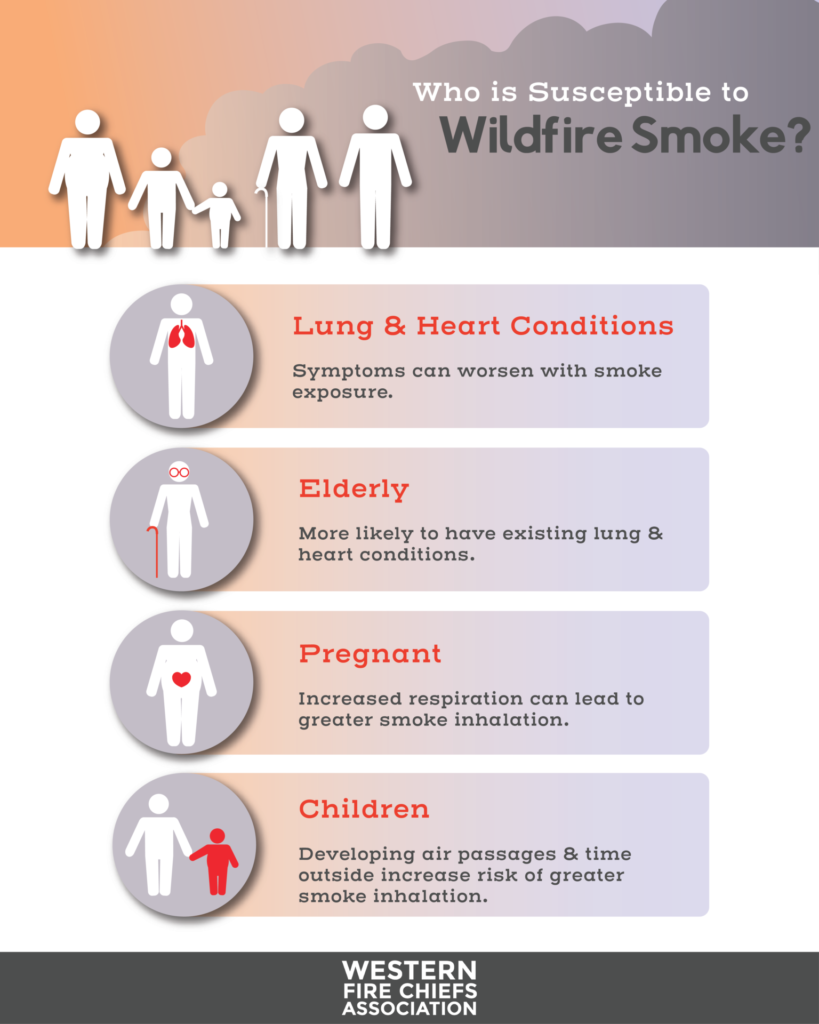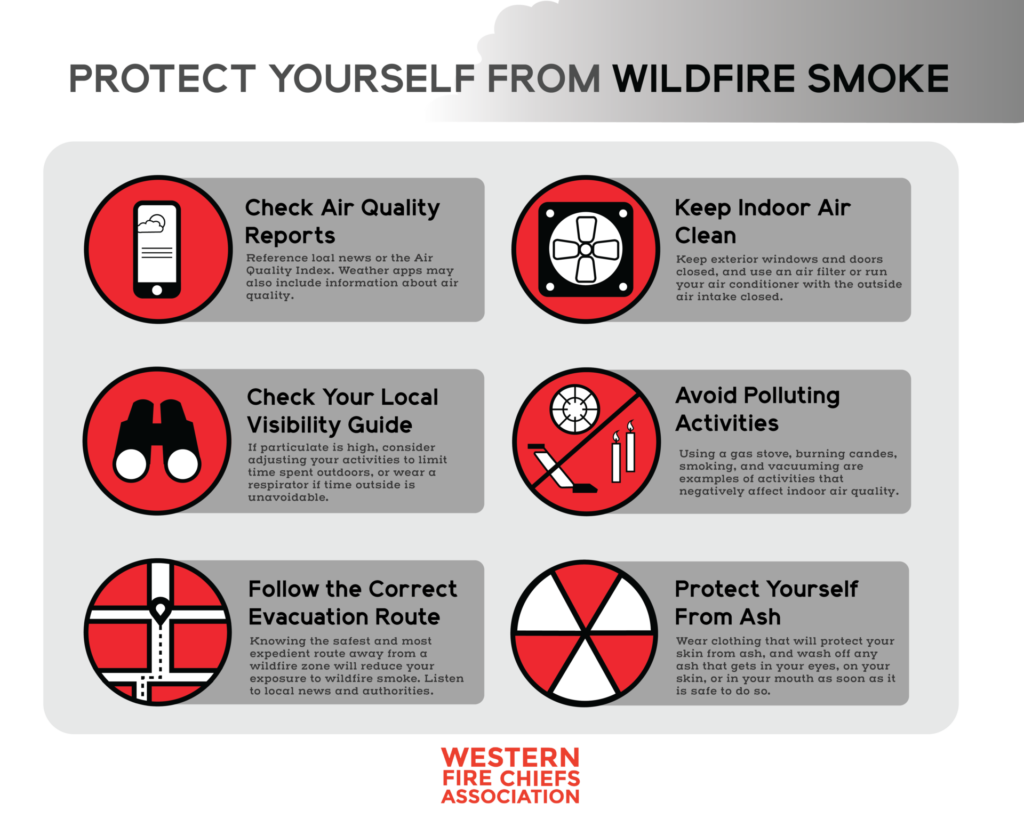Fire Pit Safety Tips
Stay safe around the campfire with tips from the Western Fire Chiefs Association. Learn essential precautions and practices for a worry-free outdoor campfire.
Wildfire smoke can have dangerous health effects. Learn which demographics are the most vulnerable, and how to protect yourself from wildfire smoke with tips from the Western Fire Chiefs Association (WFCA).
Published:July 5, 2022
Edited:March 4, 2024

As anyone from Oregon, Washington, or California can confirm; you don’t need to live next door to a wildfire to be exposed to its smoke. Smoke pollution from wildfires can travel tremendous distances, with particulate from California fires creating hazy, unhealthy air conditions as far away as New York, Philadelphia, and eastern parts of Canada.1 No matter where you live, it is important to learn how to protect yourself from wildfire smoke to preserve your health while preparing for the possibility of additional adverse conditions.
Wildfire smoke can have detrimental effects on anyone exposed to it. Some individuals are more susceptible to adverse health issues from smoke, so it is essential to know if you fit into one of the high-risk categories.
Four population demographics are at the greatest risk of experiencing health issues from wildfire exposure.

The first category includes people with an existing lung or heart condition. Symptoms from asthma or COPD often worsen when exposed to wildfire smoke.
Older adults also tend to be more affected by smoke than younger people, which comprises the second category. This issue might be due to the higher risks of having existing lung or heart problems.
The third category involves expectant mothers. The physical changes that occur during pregnancy, such as an increase in natural breathing, can cause more smoke to be inhaled. There could also be risks for preterm births or newborns with below-average birth weight due to smoke inhalation. 1
Children are the final high-risk category. Since a child’s air passageways are still developing, they breathe more air than adults when measured per pound of weight.3 Kids are also more likely to spend time outside when wildfire smoke is in the environment.
Due to their greater sensitivity, children are also at higher risk of experiencing emotional distress, such as grief and anxiety, following a fire.3
The health effects of breathing wildfire smoke for people in a high-risk category could include any or all of the following symptoms.3
The wildfire smoke long-term health effects can contribute to future breathing problems, including asthma. Depending on the particles included in the smoke, more serious conditions can also develop.
Dry conditions increase the potential for wildfires. If you live nearby to or visit a wilderness area, it’s crucial to stay alert for smoke. It can hurt your eyes, cause respiratory system irritation, and worsen chronic lung or heart conditions.
The best way to protect yourself from wildfire smoke is to be prepared for a wildfire.
Once you have these essentials prepared, the following tips can help protect you from wildfire smoke.

If a wildfire is in your area, it helps to watch the news or listen to reports of health warnings related to smoke. Some communities provide information to the Air Quality Index. Many weather apps also include an air quality feature.
You can also check the AirNow smoke map for additional information.
When you know a fire is close, pay attention to any public health messages or emergency broadcasts so that you can implement appropriate safety measures.
The health effects of wildfire smoke can be dangerous, even if you’re indoors.
When local authorities advise people to stay inside because of wildfire smoke, the goal should be to keep the air indoors as clean as possible. One option is to operate your air conditioner with the air intake closed to prevent outdoor air from getting inside.
Most homes have an interior room that can be closed off from the outside air. It helps to have a portable filter or air cleaner available in this space to ensure there’s at least one area where relief is available.
If you don’t have an air conditioner and staying inside is too warm with the windows closed, seek safety at a designated shelter.
Anything that adds pollution to the indoor environment should be avoided whenever possible when wildfire smoke is outside. Gas stoves, fireplaces, and candles reduce air purity. Even vacuuming (which stirs up dust particles) should be postponed.
The effects of wildfire smoke on health should not be underestimated. Even a small reduction of pollution-generating activities indoors can have a positive impact on health.
Some communities offer a guide that measures the particle content of the air. This information provides guidelines for people to determine if there is enough pollution to limit outdoor activities.
If you need to go outside during poor conditions, use a respirator that filters ash and smoke before the air reaches your lungs. The people who are the most susceptible to wildfire smoke should have this tool in their emergency supplies.
Dust masks won’t provide protection from the tiny particles that wildfire smoke contains. Follow the advice of your healthcare provider or doctor to ensure you can stay safe in these conditions.
It is important to use the safest and most expedient route away from a wildfire zone to reduce your exposure to smoke. Although evacuation paths are designated when wildfires develop, those routes can be subject to change. Listen to the news or follow the instructions of local authorities to ensure you’re following the current orders. When someone says it’s time to go, make sure you know where to evacuate.
Only take essential items with you when you must leave your home because of a wildfire. It also helps to plan alternative routes in case of heavy traffic and blockages.
It helps to have safety packs already prepared for each person. The Red Cross offers one example of this idea with the Pillowcase Project, listing everything that should be packed in advance so that you can grab it and go during an emergency.
When you receive wildfire smoke exposure, you can have ash and other materials deposited on your skin and clothing. These particulates can irritate your skin, nose, and eyes.
It helps to wear long-sleeved shirts, long pants, gloves, socks, and shoes to protect yourself. Goggles can help protect your eyes, even if you already wear glasses.
Wash off the ash that gets in your eyes, on your skin, or in your mouth as soon as it is safe. Children should be assisted by a trustworthy adult.
It is possible for plumbing systems and well water to become contaminated from wildfire and / or smoke. The water might have a different odor or color than normal. If water in your home is affected, try to flush the lines until the smell is gone and don’t drink it until professional testing occurs.
Wildfires can generate plenty of smoke, but you can protect yourself from its adverse effects. If you don’t have a plan to follow yet, start making one today so that you and your family can stay safe.
Stay safe around the campfire with tips from the Western Fire Chiefs Association. Learn essential precautions and practices for a worry-free outdoor campfire.
Discover essential firework safety tips to ensure a dazzling display without accidents. Learn how to celebrate responsibly with expert guidance from WFCA.
Explore the role of AI in wildfire prediction with guidance from the WFCA. Learn how advanced algorithms and data analytics enhance early detection and response.